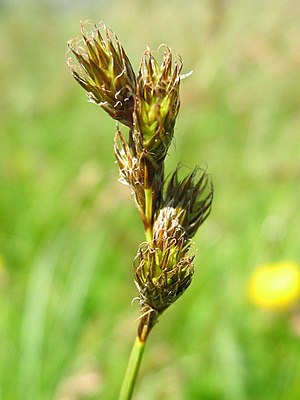Harespaw Sedge
| Harespaw Sedge | ||||||||||||
|---|---|---|---|---|---|---|---|---|---|---|---|---|

Harespaw Sedge ( Carex ovalis ) |
||||||||||||
| Systematics | ||||||||||||
|
||||||||||||
| Scientific name | ||||||||||||
| Carex ovalis | ||||||||||||
| Gooden. |
The Carex Leporina ( Carex leporina L. ; Syn .: Carex ovalis . Good ), and rabbit Sedge , Hasenfuß sedge or rabbits sedge called, is a species of the genus sedge ( Carex ) within the family of Cyperaceae (Cyperaceae). It is common from Europe to West Asia.
description
Vegetative characteristics
The hare's paw sedge is a deciduous, perennial herbaceous plant that reaches heights of between 10 and 60 centimeters. It does not form runners , but small to medium-sized solid clumps that do not disintegrate. Their stems have tangible knots at the bottom, which are usually 2 to 3 millimeters thick and appear rounded, triangular. In addition to flowering shoots, there are also vegetative shoots with several layers of leaves arranged one above the other.
The leaves are always shorter than the stem, 2 to 4 millimeters wide, rigid, light green to yellow-green in color and folded twice on the inside in the upper half; they usually run into a clear, usually long, triangular point. The leaf sheaths have distinct dark green nerve lines, but are mostly pale, rarely brown in color.
Generative characteristics
The hare's paw sedge is a sedge of the same age. The inflorescence , which is up to 4 centimeters long, contains four to seven spikelets when standing together . The yellow-brown to brown spikelets are egg-shaped with a length of 6 to 10 millimeters and a width of 5 to 7 millimeters. The female flowers are at the tip of the spikelet and the male flowers at the base. The elongated, pointed husks are as long as the 3 to 5 millimeters long and 2 millimeters wide winged tubes, which are not spread when ripe. They enclose two scars.
The species chromosome number is 2n = 64, 66 or 68.
ecology
The hare's paw sedge is a hemicryptophyte . There is also vegetative reproduction with the help of their rhizome .
The flowering time is in June and July. The pollination is carried by the wind ( anemophily ), but it is believed that in this Seggenart insects could act as pollinators ( Entomophilie ). For example, their long-lived seeds self-propagate ( autochory ).
Occurrence
The hare's foot sedge is common in the temperate zones of Eurasia. It is also found in the Azores, northwest Africa, and from western Canada to the western United States. In the other areas of North America as well as in Tasmania and New Zealand it is a neophyte .
The hare's paw sedge is relatively widespread throughout Germany , it is only rare in arid regions and on lime-rich soils . In the Allgäu Alps in Bavaria, it rises at the summit of the Schnippenkopf up to 1820 m above sea level.
The lime-avoiding hare paw sedge occurs on moist to sometimes waterlogged and often acidic meadows , pastures and grasslands . It is part of Kleinseggenrieden. It is also found on the edges of ditches or in forest fields. It thrives on dammed-seepage damp or alternately damp, moderately nutrient-rich, base-poor, peaty soils.
Taxonomy
A synonym of Carex leporina L. is Carex ovalis Good. Carex ovalis was first published by Samuel Goodenough in Trans. Linn. Soc. London 2: 148 (1794).
literature
- Rudolf Schubert, Walter Vent (Ed.): Excursion flora from Germany. Founded by Werner Rothmaler. 8th edition (new edition). Volume 4: Vascular Plants: Critical Volume, Gustav Fischer, Jena 1994, ISBN 3-334-60830-1 .
- E. Foerster: Sedges, rushes, ledges and other mock grasses of grassland - a key to determining in the flowerless state. Manuscript, Kleve-Kellen March 1982.
- Jürke Grau , Bruno P. Kremer, Bodo M. Möseler, Gerhard Rambold, Dagmar Triebel: Grasses. Sweet grasses, sour grasses, rushes and grass-like families in Europe (= Steinbach's natural guide ). New, edit. Special edition edition. Mosaik, Munich 1996, ISBN 3-576-10702-9 .
Individual evidence
- ↑ a b c d Harespaw Sedge. In: FloraWeb.de.
- ^ Georg August Pritzel , Carl Jessen : The German folk names of plants. New contribution to the German linguistic treasure. Philipp Cohen, Hannover 1882, p. 82 ( online )
- ↑ a b Erich Oberdorfer : Plant-sociological excursion flora for Germany and neighboring areas . With the collaboration of Angelika Schwabe and Theo Müller. 8th, heavily revised and expanded edition. Eugen Ulmer, Stuttgart (Hohenheim) 2001, ISBN 3-8001-3131-5 , pp. 175 .
- ↑ Rafaël Govaerts (ed.): Carex leporina. In: World Checklist of Selected Plant Families (WCSP) - The Board of Trustees of the Royal Botanic Gardens, Kew . Retrieved October 15, 2016.
- ↑ Erhard Dörr, Wolfgang Lippert : Flora of the Allgäu and its surroundings. Volume 1, IHW, Eching 2001, ISBN 3-930167-50-6 , p. 250.
Web links
- Harespaw Sedge. In: FloraWeb.de.
- Harespaw Sedge . In: BiolFlor, the database of biological-ecological characteristics of the flora of Germany.
- Profile and distribution map for Bavaria . In: Botanical Information Hub of Bavaria .
- Carex leporina L. In: Info Flora , the national data and information center for Swiss flora .
- Distribution in the northern hemisphere from: Eric Hultén, Magnus Fries: Atlas of North European vascular plants. 1986, ISBN 3-87429-263-0 at Den virtuella floran. (swed.)
- Thomas Meyer: Data sheet with identification key and photos at Flora-de: Flora von Deutschland (old name of the website: Flowers in Swabia )



